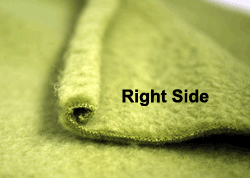Hopefully these sewing tips and tricks will make sewing these Cuddle Pillows more enjoyable. Even if you already know how to sew, these tricks might make it even easier and more fun.


If you are having trouble threading your needle, this might help. If you don't have a needle threader as shown in the picture, getting the end of the thread wet will make it easier. If this still isn't working, twisting the end of the thread should help. Cutting the tip of the thread will make it easier to put the thread through the eye of the needle.

After you thread your needle, there are two ways to knot the thread. One way is by doubling the thread and then tying a double or triple knot using both ends of the thread; this creates a circle and is recommended for beginning sewers. The other way to knot the thread is by tying a double or triple knot on only one end of the thread and the other thread is left hanging. This has the danger of the needle falling off and is not reccommended.


Before you sew anything, it is a good idea to pin your fabric. It only takes a few seconds and could save minutes in the long run. If you don't have straight pins, you can use safety pins. If you are using a sewing machine, make sure to put the pins a little more than an inch from the edge. This way you don't ruin your pins or sewing machine. If you are sewing by hand, make sure not to stab yourself. :)
This is the simplest sewing stitch to use. It is called the Running Stitch or the Straight Stitch. This is simply going up and down through the fabric. We recommend using this stitch for sewing the bulk of the pillow.

Before you sew your pillow together, sew on the facial features if you are using them. Also, while sewing use similar color thread and small, tight stitches. Place the right side of the second fabric on top of the fabric that you just embellished.


WARNING!!
We recommend not using googly eyes or buttons because they are a choking hazard for young children. We recommend using the hand crafted felt eyes and mouth that we mentioned above and on the templates page.


We keep talking about the right and wrong sides of your fabric; here are a few examples (see the pictures above) of the right and wrong sides. Also, with some types of fleece, the fabric will curl onto the right side of the fabric after it's cut.

Once your pillow is sewn and you have turned it right side out, if are having trouble getting the corners, points or edges straightened out; you can use a chopstick. If you don't have a chopstick handy, you can use an actual twig from a tree. It is a good idea to wash the twig before you use it. If you don't have any twigs handy, you can use a pencil or anything else that is relatively chopstick shaped. :)
This stitch is called the invisible stitch or the blind stitch. We recommend using this stitch to sew up the 2 to 3 inch gap left for stuffing. Even though this is the invisible stitch, we recommend using a similar color thread to your fabric in case it shows.




